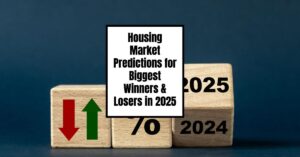Imagine the hustle and bustle of a busy city where people are always on the move, especially when it comes to buying homes. Goldman Sachs predicts home prices to rise more than 4% in 2025, a projection that many are watching closely as the housing market continues to show signs of life. With factors like changes in interest rates and the fluctuating job market at play, this forecast raises many questions about what it means for homebuyers, homeowners, and those looking to invest in properties.
Housing Market Forecast for Next Year: Prices to Rise by 4.4%
Key Takeaways:
- Home prices in the U.S. are expected to rise 4.4% in 2025.
- Lower interest rates due to Federal Reserve actions are driving this increase.
- The housing supply remains constrained, contributing to ongoing price appreciation.
- Recent mortgage rate declines have not yet led to a significant increase in applications.
- Different U.S. regions are experiencing varying levels of price growth, with the Midwest and Northeast showing the strongest increases.
U.S. Housing Market Outlook
The housing market has always been influenced by a myriad of factors, and the recent insights from Goldman Sachs shed light on what might be ahead. Analysts at Goldman Sachs have upped their home price appreciation forecasts based on several vital factors, stating that the economy remains robust, and interest rates are anticipated to decline. But what does this mean for the average person? Let’s dive deeper into this important topic.
Current Trends in Home Prices
The market has seen significant fluctuations as a result of economic conditions and global events. At the onset of the pandemic, many feared a drop in property values. Contrary to expectations, the opposite happened. With many people opting for homeownership during lockdowns, the demand for houses surged.
This led to an unprecedented rise in prices, which peaked at about 20% annually. Recently, annual home price growth has settled around 5.5%, hinting that the demand is far from satisfied, especially with a demographic surge of potential buyers seeking homes in the age bracket of 30 to 39 years who are starting families.
Interestingly, the cost of mortgages has seen a substantial decline, dropping from a peak above 7.8% in October 2023 to under 6.5% recently. This decrease in mortgage rates paves the way for more affordable home-buying opportunities, allowing more potential homeowners a chance to enter the market despite the historical challenges of affordability.
Recommended Read:
Factors Driving Home Price Growth
One key factor driving the rise in home prices as forecasted by Goldman Sachs is the anticipated interest rate cuts by the Federal Reserve. As the labor market shows signs of loosening, economists predict that the Fed will implement multiple rate reductions in the near future. Lower rates mean lower costs for borrowing, which in turn makes homes more affordable for buyers even as prices continue to climb.
Interestingly, the phrase “bad news is likely good news” reflects the current sentiment in the market. Analysts suggest that concerns about economic downturns can lead to interest cuts that ultimately benefit homebuyers. As employment concerns continue to circulate, it appears that home prices are resilient, with low permanent layoff rates supporting a stable job market.
The Affordability Conundrum
While home prices are on the rise, the issue of affordability remains a hot topic. Current levels of affordability are said to be the worst they have been since the early 1980s. The anxiety surrounding rising prices has led many to wonder if potential buyers will be priced out of the market entirely.

In the past, affordability problems were often resolved by sudden drops in home prices. However, Goldman Sachs believes that the current scenario may lead to a more gradual return to normalized levels of affordability. With mortgage rates expected to decrease further and real disposable incomes projected to grow modestly, there may still be hope for buyers who want to enter the market.
Regional Variations in Home Prices
The predicted growth in home values isn’t uniform throughout the United States. According to Goldman Sachs, some regions are seeing much healthier appreciation rates than others. The Midwest, often recognized as the most affordable part of the country, is experiencing notable price hikes, particularly in cities like Cleveland and Chicago.
The Northeast, with hubs such as New York and Boston, has also displayed strong home price growth. Conversely, in California, markets such as San Diego are thriving, despite historical concerns about affordability challenges. Meanwhile, the Southeast, especially Florida, has shown a drop in affordability that challenges its previous status as a budget-friendly destination.
The Future of Home Prices and Economy
Looking ahead, Goldman Sachs has expressed optimism about the housing market, expecting it to remain buoyant with 4.4% in 2025. There are a couple of factors that contribute to this positive outlook.
First, the anticipated interest rate cuts appear likely to encourage buyer activity when it comes to mortgages. Analysts predict that decreases in lending costs will assist buyers who have been sitting on the fence for quite some time.
Second, while affordability issues persist, income growth is projected to remain positive, providing more purchasing power for buyers. The challenge remains to see if these factors will create a balance, stabilizing the market without resulting in a drastic home price drop.
Consumer Sentiment and Market Anticipations
Despite noticeable shifts in mortgage rates, the market hasn’t yet seen a surge in mortgage applications. This stall might be due to a combination of seasonal predictability and buyer hesitance to jump into a fluctuating market. As families begin to settle into a routine with school-age children, it’s common for many to decide against moving during this transitional period.
Moreover, the long-term projection from Goldman Sachs suggests a gradual recovery towards a more favorable affordability level by the end of the decade, calling for patience from both prospective buyers and real estate investors.
Throughout this evolving scenario, it remains vital for market observers and potential buyers to keep in touch with regional trends, noting that differences exist even within a country that seems unified under certain economic pressures.
As the housing market continues to unfold, it will be fascinating to see how these predictions play out. Factors like the Federal Reserve's policies, employment rates, and household dynamics will undoubtedly shape the experiences of homebuyers and owners in the coming years.
Also Read:
- Housing Market Predictions for the Next 4 Years: 2024 to 2028
- Real Estate Forecast Next 5 Years: Top 5 Predictions for Future
- Is the Housing Market on the Brink in 2024: Crash or Boom?
- 2008 Forecaster Warns: Housing Market 2024 Needs This to Survive
- Housing Market Predictions for the Next 2 Years
- Real Estate Forecast Next 10 Years: Will Prices Skyrocket?
- Housing Market Predictions for Next 5 Years (2024-2028)
- Housing Market Predictions 2024: Will Real Estate Crash?
- Housing Market Predictions: 8 of Next 10 Years Poised for Gains
- Trump vs Harris: Which Candidate Holds the Key to the Housing Market (Prediction)











